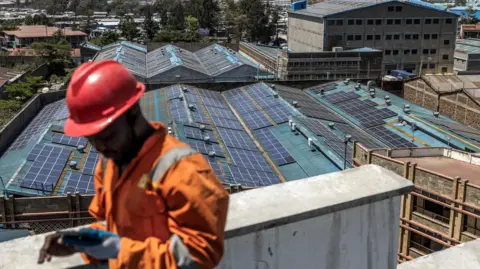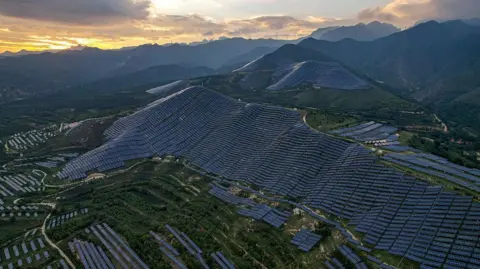Business
Renewables overtake coal as world’s biggest source of electricity

 Justin RowlattClimate Editor
Justin RowlattClimate Editor AFP via Getty Images
AFP via Getty ImagesRenewable energy overtook coal as the world’s leading source of electricity in the first half of this year – a historic first, according to new data from the global energy think tank Ember.
Electricity demand is growing around the world but the growth in solar and wind was so strong it met 100% of the extra electricity demand, even helping drive a slight decline in coal and gas use.
However, Ember says the headlines mask a mixed global picture.
Developing countries, especially China, led the clean energy charge but richer nations including the US and EU relied more than before on planet-warming fossil fuels for electricity generation.
This divide is likely to get more pronounced, according to a separate report from the International Energy Agency (IEA). It predicts renewables will grow much less strongly than forecast in the US as a result of the policies of President Donald Trump’s administration.
Coal, a major contributor to global warming, was still the world’s largest individual source of energy generation in 2024, a position it has held for more than 50 years, according to the IEA.
China remains way ahead in clean energy growth, adding more solar and wind capacity than the rest of the world combined. This enabled the growth in renewable generation in China to outpace rising electricity demand and helped reduce its fossil fuel generation by 2%.
India experienced slower electricity demand growth and also added significant new solar and wind capacity, meaning it too cut back on coal and gas.
In contrast, developed nations like the US, and also the EU, saw the opposite trend.
In the US, electricity demand grew faster than clean energy output, increasing reliance on fossil fuels, while in the EU, months of weak wind and hydropower performance led to a rise in coal and gas generation.
In a separate report the IEA has halved its forecast for the growth of renewable energy in the US this decade. Last year, the agency predicted the US would add 500GW of new renewable capacity – mostly from solar and wind – by 2030. That has been cut that back to 250GW.
The IEA analysis represents the most thorough assessment to date of the impact the Trump administration’s policies are having on global efforts to transition to cleaner energy sources and underscores the dramatically different approach of the US and China.
As China’s clean tech exports surge, the US is focusing on encouraging the world buy more of its oil and gas.
 Getty Images
Getty Images‘Crucial’ turning point
Despite these regional differences, Ember calls this moment a “crucial turning point”.
Ember senior analyst Malgorzata Wiatros-Motyka said it “marks the beginning of a shift where clean power is keeping pace with demand growth”.
Solar power delivered the lion’s share of growth, meeting 83% of the increase in electricity demand. It has now been the largest source of new electricity globally for three years in a row.
Most solar generation (58%) is now in lower-income countries, many of which have seen explosive growth in recent years.
That’s thanks to spectacular reductions in cost. Solar has seen prices fall a staggering 99.9% since 1975 and is now so cheap that large markets for solar can emerge in a country in the space of a single year, especially where grid electricity is expensive and unreliable, says Ember.
Pakistan, for example, imported solar panels capable of generating 17 gigawatts (GW) of solar power in 2024, double the previous year and the equivalent of roughly a third of the country’s current electricity generation capacity.
Africa is also experiencing a solar boom with panel imports up 60% year on year, in the year to June. Coal-heavy South Africa led the way, while Nigeria overtook Egypt into second place with 1.7GW of solar generating capacity – that’s enough to meet the electricity demand of roughly 1.8m homes in Europe.
Some smaller African nations have seen even more rapid growth with Algeria increasing imports 33-fold, Zambia eightfold and Botswana sevenfold.
In some countries the growth of solar has been so rapid it is creating unexpected challenges.
In Afghanistan, widespread use of solar-powered water pumps is lowering the water table, threatening long-term access to groundwater. A study by Dr David Mansfield and satellite data firm Alcis warns that some regions could run dry within five to ten years, endangering millions of livelihoods.
Adair Turner, chair of the UK’s Energy Transitions Commission, says countries in the global “sun belt” and “wind belt” face very different energy challenges.
Sun belt nations – including much of Asia, Africa, and Latin America – need large amounts of electricity for daytime air conditioning. These countries can significantly reduce energy costs almost immediately by adopting solar-based systems, supported by increasingly affordable batteries that store energy from day to night.
Wind belt countries like the UK face tougher obstacles, however. Wind turbine costs have not come down by anything like as much as solar panels – down just a third or so in the last decade. Higher interest rates have also added to borrowing costs and raised the overall price of installing wind farms significantly in the last few years.
Balancing supply is harder too: winter wind lulls can last for weeks, requiring backup power sources that batteries alone can’t provide – making the system more expensive to build and run.
But wherever you are in the world, China’s overwhelming dominance in clean tech industries remains unchallenged, other new data from Ember shows.
In August 2025, its clean tech exports hit a record $20bn, driven by surging sales of electric vehicles (up 26%) and batteries (up 23%). Together, China’s electric vehicles and batteries are now worth more than twice the value of its solar panel exports.

Business
Index reshuffle: IndiGo parent to enter Sensex from Dec 22; Tata Motors Passenger Vehicles dropped – The Times of India

InterGlobe Aviation, the operator of IndiGo, will be included in the BSE’s 30-stock benchmark index Sensex from December 22, the BSE Index Services said on Saturday.As part of the reconstitution exercise, Tata Motors Passenger Vehicles Ltd will be dropped from the index, the announcement added, PTI reported.The changes will take effect from market open on Monday, December 22, and have been made by BSE Index Services Pvt Ltd (formerly Asia Index Pvt Ltd).In the broader BSE 100 index, IDFC First Bank Ltd will be added, replacing Adani Green Energy Ltd. Within the BSE Sensex 50 index, Max Healthcare Institute Ltd will be included, while IndusInd Bank Ltd will be removed.Further, in the BSE Sensex Next 50 index, IndusInd Bank and IDFC First Bank will replace Max Healthcare Institute and Adani Green Energy.
Business
India’s New Four Labour Codes: From Gratuity After One Year To Free Annual Health Checkups; Who Will Receive Gratuity In Case Of Private Sector Employee’s Death?
)
New Labour Codes In India: The Government of India has introduced a major reform that will benefit lakhs of employees who frequently change jobs, including fixed-term employees, women, gig workers, MSME staff, and contract workers. Under the new Labour Codes, the minimum service required to receive gratuity has been reduced from five years to just one year. This means more workers will now be eligible for gratuity even if they don’t stay long in one organisation.
This major reform is part of the government’s plan to replace 29 old labour laws with four new Labour Codes. These include the Code on Wages, the Industrial Relations Code, the Social Security Code, and the Occupational Safety Code, replacing outdated regulations framed between the 1930s and 1950s. The goal is to make business processes smoother, improve worker welfare, update outdated rules, and create a more transparent and worker-friendly labour system.
Gratuity: What It Is And What Happens After Private Employee’s Death
It is a one-time amount that employers give to employees as a thank-you for their service. Under the Payment of Gratuity Act, private sector employees can receive gratuity when they leave a job (due to resignation or termination), retire, or become disabled. In case of an employee’s death, the amount is paid to their nominee. Earlier, employees had to complete at least five years of continuous service with the same employer to be eligible, except in situations of death or disability. (Also Read: What Is EPS-95 Scheme? If Employee Becomes Permanently Disabled, Will He Get Pension? Check Benefits, Eligibility Criteria, And How It Is Calculated)
New Labour Codes: How New Gratuity Rule Strengthens Worker Security?
With this reform, employees will not be penalised for having short job tenures, giving young workers who often switch jobs better financial security. It also benefits contractual, fixed-term, and gig workers by making gratuity easier to receive and more predictable. By offering gratuity to more people, the government is encouraging formal employment and improving the safety net for all workers. Overall, this change makes India’s workforce more secure and brings labour benefits closer to global standards.
New Labour Codes: Benefits Including Free Annual Health Check-Ups
For the first time, all workers, whether permanent, contractual, or fixed-term, must receive appointment letters, which improves job security and helps reduce disputes. The new Labour Codes also make preventive healthcare mandatory, requiring employers to provide yearly health checkups for workers aged 40 and above, helping with early detection and lowering long-term health risks.
Under the Code on Wages, every worker across all sectors is now entitled to minimum wages, ensuring that no one falls below a basic income level. Adding further, women are allowed to work in all types of jobs, including night shifts, giving them greater employment opportunities and flexibility.
Business
Byju Raveendran Faces USD 1 Billion Default Judgment In US, Plans Appeal

Last Updated:
US court orders Byju Raveendran to repay USD 1 billion to BYJU’s Alpha and GLAS Trust Company LLC. Raveendran plans to appeal.
Byju’s founder Byju Raveendran has challenged a recent default judgment by a US bankruptcy court that holds him liable for repaying over USD 1 billion.
In a major setback, the US Delaware court has ordered Byju Raveendran, the founder of ed-tech, to repay USD 1 billion to BYJU’s Alpha and US-based GLAS Trust Company LLC, according to a report of PTI. The court has held Raveendran personally liable for the damage upon the petition filed by the lender.
The court also found that Raveendran lapsed to comply with the discovery order and continued to be evasive on several occasions. “The court will enter default judgment against Defendant Raveendran…in the amount of USD 533,000,000, and on Counts II, V and VI in the amount of USD 540,647,109.29,” the judgement said, as reported by PTI.
Byju Raveendran is going to contest the US court judgement.
In a press statement, Raveendran’s lawyers said they will “promptly appeal” the ruling, arguing that the court issued the judgment on an expedited timeline that “precluded” him from presenting his side. Raveendran has denied all allegations made in the case.
The legal team also accused GLAS Trust of misleading the Delaware Courts and the public, claiming the judgment should not have been issued at all. According to them, the court granted monetary relief even though GLAS had withdrawn its damages claim in September 2025.
“This judgment stems from an accelerated procedure triggered by serious misrepresentations made by GLAS,” the release stated. The team added that Raveendran will soon submit evidence of this alleged misconduct as part of a separate claim worth at least USD 2.5 billion, which he plans to file before the US courts.
The statement further said the latest Delaware Court ruling was a direct result of GLAS “securing judicial relief by misleading the courts,” with the aim of harming Raveendran personally and indirectly affecting other suspended directors of Think & Learn Pvt. Ltd.
Raveendran’s team also highlighted that he was given insufficient time to hire legal counsel and respond to the accelerated court actions.

Varun Yadav is a Sub Editor at News18 Business Digital. He writes articles on markets, personal finance, technology, and more. He completed his post-graduation diploma in English Journalism from the Indian Inst…Read More
Varun Yadav is a Sub Editor at News18 Business Digital. He writes articles on markets, personal finance, technology, and more. He completed his post-graduation diploma in English Journalism from the Indian Inst… Read More
November 22, 2025, 18:19 IST
Read More
-

 Tech1 week ago
Tech1 week agoNew carbon capture method uses water and pressure to remove CO₂ from emissions at half current costs
-

 Politics1 week ago
Politics1 week agoBritish-Pakistani honoured for transforming UK halal meat industry
-

 Business1 week ago
Business1 week agoThese 9 Common Money Mistakes Are Eating Your Income
-

 Sports7 days ago
Sports7 days agoTexas A&M officer scolds South Carolina wide receiver after touchdown; department speaks out
-

 Fashion1 week ago
Fashion1 week agoAfter London, Leeds and Newcastle, next stop Glasgow for busy Omnes
-

 Tech1 week ago
Tech1 week ago$25 Off Exclusive Blue Apron Coupon for November 2025
-

 Sports1 week ago
Sports1 week agoApple scrapping MLS Season Pass service in ’26
-

 Business1 week ago
Business1 week agoWhat’s behind Rachel Reeves’s hokey cokey on income tax rises?







